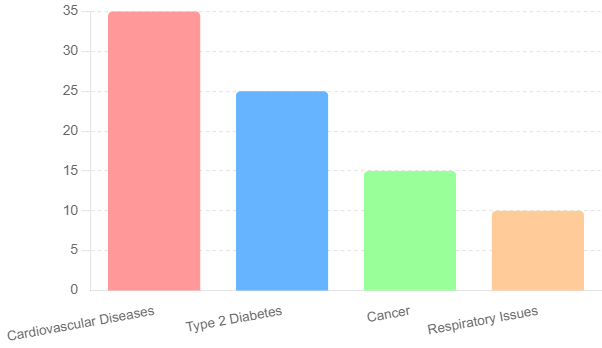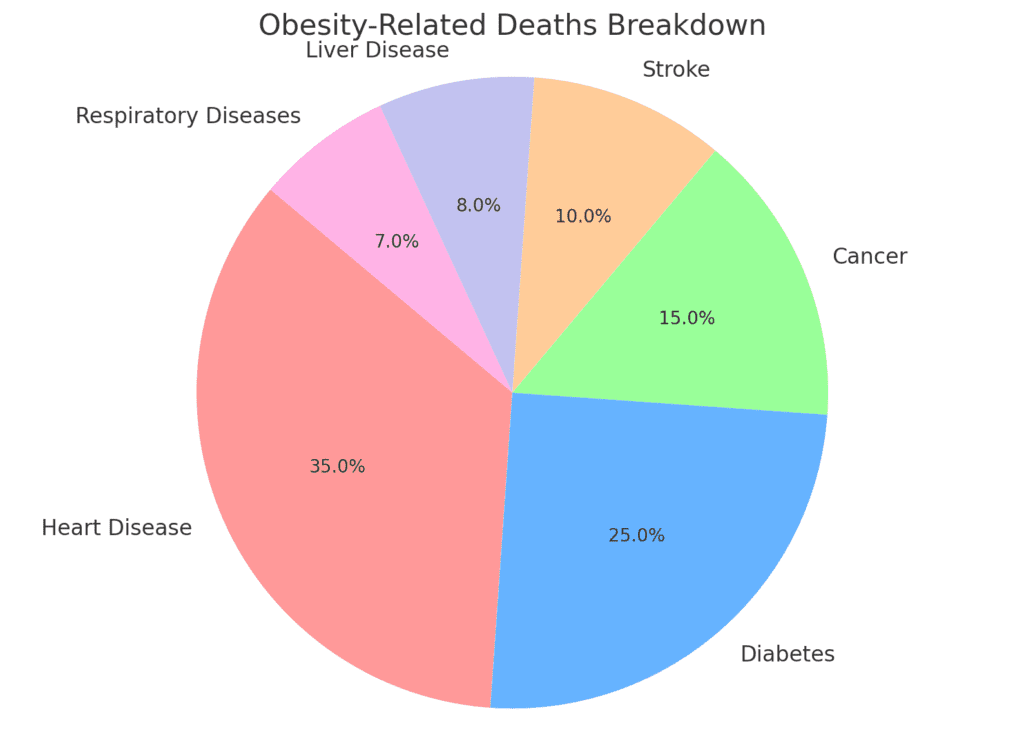The Connection Between Obesity and Death Rates

Obesity is a major global health problem that has been increasing steadily over the years. It’s important to understand how obesity and death rates are connected to address this public health crisis. The rise in obesity rates has serious health consequences, including higher death rates.
This guide delves into the impact of obesity on mortality, offering key statistics that highlight its seriousness. It also breaks down the various causes of death related to obesity. So, let’s dive in!
Understanding Obesity and Its Prevalence
Obesity means having too much body fat, usually measured by Body Mass Index (BMI). A BMI of 30 or higher is considered obese. In recent decades, a lack of physical activity, unhealthy eating habits, and genetic factors have caused obesity rates to soar.
Obesity Deaths per Year Worldwide
The impact of obesity is huge. The World Health Organization (WHO) reports that about 2.8 million people die each year. These deaths are due to being overweight or obese. This shows how serious obesity is as a leading cause of preventable deaths around the world.
Key Statistics on Obesity and Death Rates
- Global Mortality Rates: Obesity-related conditions are among the top causes of death globally. Studies show that obesity increases the risk of death by 50-100% compared to individuals with a healthy weight.
- Cardiovascular Diseases: Cardiovascular diseases (CVD) are the leading cause of death among obese people. Obesity leads to conditions like high blood pressure, high cholesterol, and hardening of the arteries. These conditions significantly increase the risk of heart attacks and strokes.
- Type 2 Diabetes: Obesity is a major risk factor for type 2 diabetes. Obese people are more than ten times more likely to develop type 2 diabetes. This condition can cause severe complications like kidney failure, blindness, and heart diseases.
- Cancer: Obesity is linked to several types of cancer, including breast, colon, and endometrial cancer. The reasons include hormonal changes, inflammation, and insulin resistance.
- Respiratory Issues: Obesity can cause breathing problems like sleep apnea and obesity hypoventilation syndrome. These conditions significantly increase the risk of death due to respiratory failure and heart problems.

The Direct Link: Obesity Cause of Death
Obesity directly contributes to various life-threatening conditions. The most common causes of death related to obesity include:
- Heart Disease: Obesity strains the heart and increases the risk of coronary artery disease, heart attacks, and heart failure.
- Stroke: Excess body fat can lead to plaque buildup in arteries, increasing the risk of stroke.
- Diabetes Complications: Uncontrolled diabetes can lead to severe complications. These are such as kidney disease, nerve damage, and infections, which can be fatal.
- Certain Cancers: Obesity is linked to higher mortality rates in various cancers. This is due to its impact on hormone levels and chronic inflammation.
- Liver Disease: Non-alcoholic fatty liver disease (NAFLD) is common in obese individuals. Therefore, it can progress to liver cirrhosis and liver cancer.
- Respiratory Diseases: Severe obesity can lead to respiratory complications that are often fatal.

Preventive Measures and Solutions
Addressing obesity requires multiple approaches. Here are some effective strategies to combat obesity and reduce death rates:
- Healthy Diet: Adopt a balanced diet rich in fruits, vegetables, whole grains, and lean proteins.
- Regular Physical Activity: Engage in at least 150 minutes of moderate-intensity aerobic activity or 75 minutes of vigorous-intensity activity per week, along with muscle-strengthening activities.
- Behavioral Therapy: Psychological support and behavioral therapy can help individuals develop healthier eating and exercise habits.
- Medical Interventions: In some cases, medication or surgery may be necessary to treat obesity and its related health conditions.
- Public Health Policies: Governments and health organizations should implement policies that promote healthy lifestyles, such as regulating food marketing, improving access to healthy foods, and creating environments that encourage physical activity.
The connection between obesity and death rates is clear and alarming. With millions of obesity-related deaths occurring each year, it is crucial to take action at both individual and societal levels.
By understanding the causes and consequences of obesity, we can work towards reducing its prevalence and the associated mortality rates.
Through healthy lifestyle choices, medical interventions, and supportive policies, we can combat this global health crisis and improve the quality of life for millions around the world.




